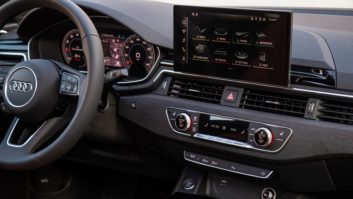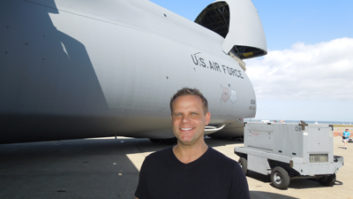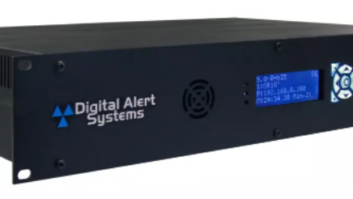The author is regional sales manager Asia/Pacific for Nautel.
HACKETT’S COVE, Nova Scotia — The implementation of digital radio technologies on a global scale is not a simple equation.

Chuck Kelly says it’s hard to beat the cost efficiency of medium wave and FM broadcasting.
Many factors play a part as each region and country chooses its standard. These include issues such as backwards-compatibility with existing analog receivers and spectral masks, the availability of frequencies in larger markets, the short- and long-term costs of broadcast infrastructure conversion, receiver availability and cost, the practicality of a transitional hybrid approach and the roadmap for future all-digital broadcast. It is also important to consider the effects of each option on the financial health of the public and private radio broadcasters involved.
THE OPTIONS
Traditional medium wave and FM bands offer many advantages. They provide good building penetration and portable/mobile performance, while a wide range of equipment both for the receiver and transmitter end are available at low cost.
Most importantly, however, these frequencies are already allocated to broadcast in most regions of the world. It’s hard to beat the cost efficiency of medium wave and FM broadcasting, especially as compared to satellite, internet or cellular broadcasts.
In some countries, the lack of available frequencies has led to one or more new bands being allocated, and DAB or DAB+ has been implemented. But this decision may have drawbacks in many parts of the world.
Suppose you own an FM station and the decision to implement DAB in your area is made. Now you must buy a spot in the multiplex, but you can’t just stop broadcasting in FM because digital receivers aren’t sufficiently available on the market — and it may be years before you can shut it off. That means your transmission cost is increased.
Meanwhile, in many cases, DAB coming to a market has brought with it new competitors to your station. The advertising pie in your market didn’t increase in size, and the slices each station makes are smaller. Thus along with increasing expenses, revenue will most likely decrease — not a healthy prospect.
This is not the case with alternative in-band technologies Digital Radio Mondiale and HD Radio. Each standard has its advantages, and despite geographic, political and revenue model differences, they are remarkably similar technologies. Both DRM and HD Radio can be used to upgrade existing analog transmitter systems to digital, both are well proven and accepted by international standards bodies and both utilize the existing medium wave and FM bands.
IN-BAND TECHNOLOGIES
HD Radio FM is a hybrid approach, where sets of digital sidebands are added to either side of the analog signal, and the whole thing fits in a spectral mask that meets standards in most countries. If you have an analog-only radio, you will continue to hear the FM analog signal as before, but if you have a new HD Radio receiver, you will hear the analog signal in addition to a higher-quality digital representation of that analog signal, plus (optionally) several more digital stations.
In DRM+, the VHF version of DRM, a narrower digital-only signal is broadcast, which fits into the small blank spaces in market dial and which can, potentially, offer more than one channel.
The primary difference is in receiver availability. There are tens of millions of HD Radio receivers in the market, albeit mostly in the United States, and millions more being sold every year. The economies of scale mean that HD Radio cost is quite reasonable and not much of a premium over an analog-only radio. Car receivers, portable and home receivers are available and HD Radio in cellphones is just beginning to be available.
DRM+ radios, on the other hand, are not being produced in mass-market quantities at present, and the costs are still quite high.
Most receivers made for HD Radio FM also support medium wave, although HD Radio on medium wave has not been as successful as it has on FM. Again, the analog signal has digital subcarriers on both sides but with medium wave, only a single digital channel is carried, the digital representation of the analog signal.
While the HD Radio medium wave signal meets the FCC spectral mask, it does cause interference to adjacent stations, and many stations have turned it off. Outside of North America, medium wave has little penetration. DRM on the contrary uses the whole channel for the digital signal and doesn’t encroach on adjacent frequencies.
ALL-DIGITAL RECEIVERS
Another key point is that ITU Region 2, which consists of the Americas, has 10 kHz frequency steps, while Regions 1 and 3 (the rest of the world) operate with 9 kHz steps. HD Radio is optimized for 10 kHz steps, and DRM is equally comfortable in either.
An additional consideration is the longer-term question: When will digital receivers allow for all-digital operation? Nautel has developed HD Multiplex, which allows up to 15 stations to be transmitted on a single HD Radio FM transmitter. These signals can be received on most current HD receivers, bringing significant advantages in spectral efficiency, operation cost and radio’s ability to compete with a multiplying number of new formats available over the internet.
Ideally, the millions of new receivers being produced each year would include both HD Radio and DRM. While this isn’t without some challenges, chipsets are today available that support both, and it would permit broadcasters to select the technology that best fits their market for both medium wave and FM.
Radio World welcomes other points of view. Please send comments to [email protected].











